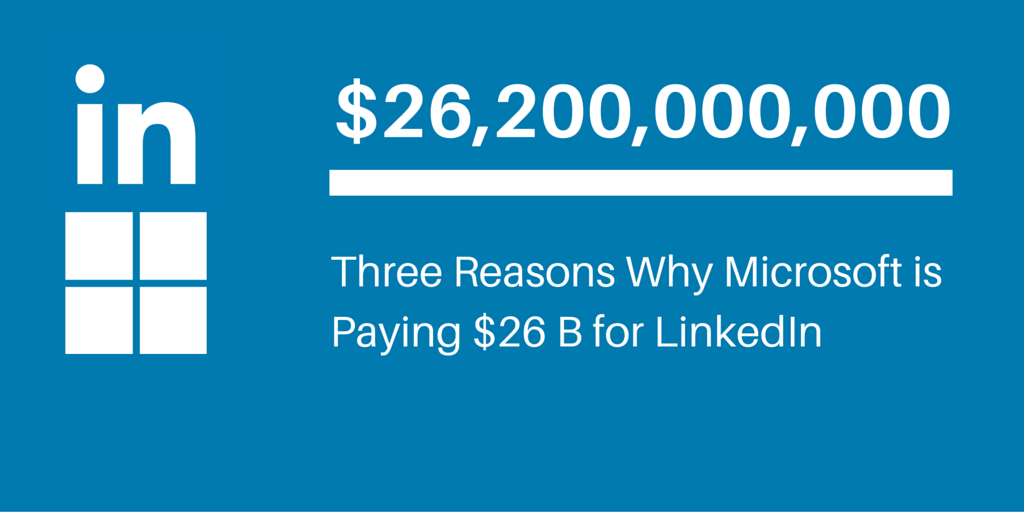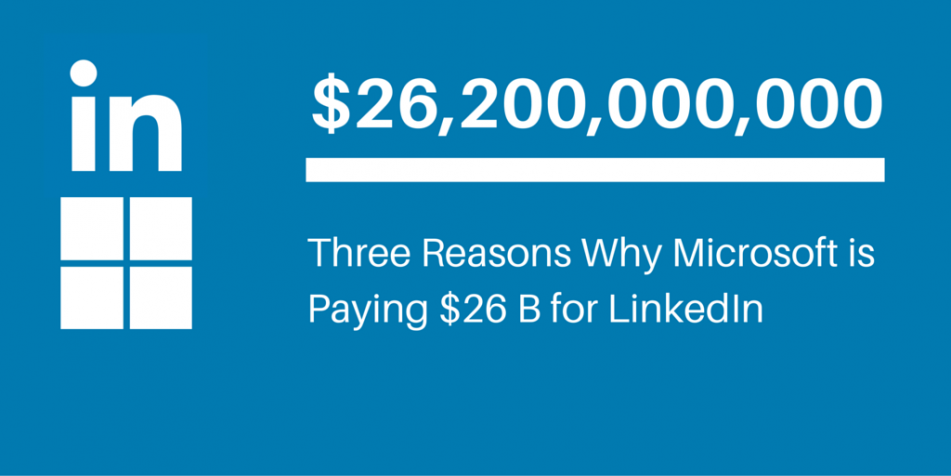
News broke today that Microsoft is set to acquire professional social networking site LinkedIn.
In an all-cash deal worth $26.2 billion the giant of professional software offer is worth $196 per share, a significant premium over LinkedIn’s Friday closing price of $131 per share.
While nowhere near the largest acquisition in history, it is amongst the biggest acquisitions in social networking, new media, and technology sectors in recent years. In particular, the $26 billion far outstrips the the $22 billion that rival network Facebook paid for messaging application company WhatsApp in 2014.
What Microsoft is getting for its money can be summarized in a few words: connections, subscriptions, and growth.
Connections
LinkedIn connections are functionally different to the ‘friends’ and ‘followers’ of competing social networks.
Unlike a Facebook Friend, for example, a LinkedIn connection represents a public alignment in a professional sense. A LinkedIn connection is someone that a user is proud to have associated with their public professional profile. There is not the same social pressure to add every second-cousin or high school classmate to your LinkedIn connection list because, far from being a space for sharing memes and holiday snaps, LinkedIn remains largely a professional space. Similarly, unlike Twitter Followers that might represent nothing more than a passing appreciation of a rock band, actor, or comedian, LinkedIn connections represent stronger and longer lasting bonds between people.
This makes the social data that LinkedIn has collected and mines incredibly attractive for a company with enterprise solutions and professional software to sell. While trawling a person’s Twitter stream for clues as to their professional interests might yield everything from a close approximation to a wildly inaccurate guess, LinkedIn is built to provide just the information that an enterprise software firm like Microsoft values so much.
Subscriptions
LinkedIn has a revenue model that is both similar to its competitors in the social space but which also has some features that the competitors cannot match.
While there is advertising on LinkedIn it is not limited to sidebar or in-feed ads promoting consumer or professional products and services. Instead, LinkedIn supplements this stock-standard social advertising with a strong and burgeoning employment program. Businesses have proven happy to search for their next hire on LinkedIn in a way that they have never sought out talent on Facebook, Google+, or Instagram – and why not? LinkedIn, after all, is a social network that is built on a profile structured similarly to a professional resume and there’s not another successful social network that offers businesses a better basis for making a strong hire.
But more than that, LinkedIn is the only major social network to have developed a subscription based revenue model that actually works. While the basic LinkedIn access is free there are additional membership levels that allow users to do more with their LinkedIn account. LinkedIn sells these membership levels with consistent reminders that the best companies are willing to pay the annual subscriptions for their employees on the site, a subtle but effective means of ensuring that the subscription services not only exist but thrive.
For Microsoft, then, LinkedIn represents the rare social network with a diverse revenue base and one of the only ones with a successful subscription model to underlie its display advertising revenues.
Growth
LinkedIn has had competitors in the professional social networking space and has managed, over time, to dispatch them all.
Competitors to LinkedIn have emerged and grown before crashing and burning rather regularly. Viadeo, for example, grew fast to count some 35 million users within a few years of launch but it had trouble expanding from its European base and ran into significant trouble finding traction in East Asia. It is now an after thought in the professional networking space, a company that woulda, shoulda and coulda been a contender if it hadn’t been for some disastrous decision making and LinkedIn’s continued expansion.
Xing, too, tried to challenge LinkedIn for the crown of the leading social network for professionals and enterprise. While the company has managed to record some impressive growth over its nearly 13 year history it has also had difficulty escaping from its linguistic and geographic boundaries. Nearly 4 out of 5 page views on Xing still come from Germany which, while a significant player in the international economy, is not at the center of the world economy in the way that the United States is.
Simply put, the 105 million unique monthly users and 160 billion annual page views that LinkedIn offers to Microsoft represents a market leading position that has dispatched every competitor, that has shown an ability to break through in all corners of the world, and that has established a lead in the race for professional networking dollars that is unlikely to be challenged.
A Smart Move by Redmond
Microsoft has made a bold but smart move in acquiring the profitable LinkedIn. While the deal is yet to be confirmed by shareholders in the social network the significant premium on the shares should ensure it sails through approval in coming months and that we enter 2017 with LinkedIn under new ownership, if not new management. The benefits to the shareholders are obvious – cash up front – and for the LinkedIn team the injection of Microsoft cash should help in the development of future products, too.
But the biggest winner is Microsoft itself that, with access to the connections, subscriptions, and market-leading positioning that LinkedIn offers it in the social networking space, can finally lay claim to clear leadership in the enterprise software, cloud, and networking space. With Google+ now little more than a laugh line and with Microsoft Office cementing its place as the cloud computing software suite of choice, Microsoft is once again back on top in the world of business tech.



18 Comments
Sutter Health
Heya i’m for the first time here. I came across this board
and I find It truly useful & it helped me out a lot.
I hope to give something back and help others like you helped
me.
Hello, everything is going perfectly here and ofcourse every one is sharing facts, that’s
genuinely fine, keep up writing.
I pay a quick visit every day some blogs and blogs
to read content, however this weblog gives quality
based posts.
Excellent site. Plenty of helpful information here. I’m sending it to some pals ans also sharing in delicious.
And obviously, thank you to your sweat!
Yes! Finally something about Understanding male
pattern baldness.
What’s up, of course this paragraph is genuinely nice and I have learned lot of things
from it regarding blogging. thanks.
Howdy this is kind of of off topic but I was wondering if blogs use WYSIWYG editors or
if you have to manually code with HTML. I’m starting a blog soon but have no coding knowledge so I wanted to get guidance from someone
with experience. Any help would be greatly appreciated!
Piano Jazz Instrumental
Everything is very open with a very clear description of the challenges.
It was really informative. Your website is
extremely helpful. Thanks for sharing!
This was beautiful Admin. Thank you for your reflections.
It’s nice to see the best quality content from such sites.
You re so awesome! I don t believe I have read a single thing like that before.
So great to find someone with some original thoughts on this topic. Really..
I couldn’t resist commenting. Perfectly written!
Hi, i think that i saw you visited my blog thus i came to “return the favor”.I
am attempting to find things to enhance my web site!I suppose its ok to use a few
of your ideas!!
Inspiring quest there. What happened after? Thanks!
It’s nice to see the best quality content from such sites.QINSHARE Car Hanging Ornament Car Decoration Mirror Hanging Car Interior Accessories for Car Rear View Mirror Hanging Accessories Christmas Hanging Ornament Gardening Hanging Car Ornament – Hot Deals